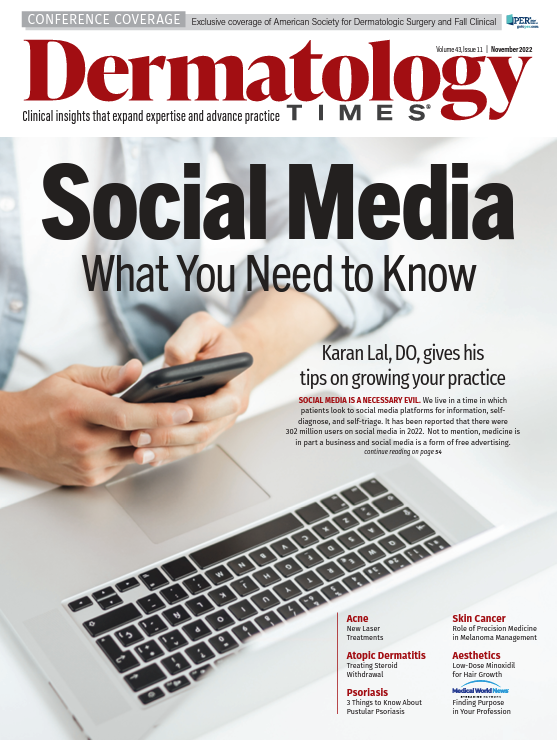- Case-Based Roundtable
- General Dermatology
- Eczema
- Chronic Hand Eczema
- Alopecia
- Aesthetics
- Vitiligo
- COVID-19
- Actinic Keratosis
- Precision Medicine and Biologics
- Rare Disease
- Wound Care
- Rosacea
- Psoriasis
- Psoriatic Arthritis
- Atopic Dermatitis
- Melasma
- NP and PA
- Skin Cancer
- Hidradenitis Suppurativa
- Drug Watch
- Pigmentary Disorders
- Acne
- Pediatric Dermatology
- Practice Management
- Prurigo Nodularis
- Buy-and-Bill
Publication
Article
Dermatology Times
What’s New and Hot in Acne and Rosacea
Author(s):
At the 2022 Fall Clinical Dermatology Conference, Valerie D. Callender, MD, FAAD, presents “What’s Hot in Acne & Rosacea.”
Valerie D. Callender, MD, FAAD, professor of dermatology at Howard University in Washinton, DC, and medical director of the Callender Dermatology & Cosmetic Center in Glenn Dale, Maryland, shared clinical updates on acne and rosacea at Fall Clinical in Las Vegas, Nevada.1
Callender began by reviewing the pathophysiology of acne, which includes:
- Follicular proliferation of cutibacterium acnes
- Abnormal keratinization
- Increased sebum production
- Inflammation
Dermatologists have a variety of treatment options to choose from when creating a treatment plan for their patients with acne vulgaris. According to the American Academy of Dermatology (AAD), there are regimes to choose from based on 1st line of treatment, alternative/additional treatment, and the severity of acne vulgaris. Common 1st line treatment options for mild acne include benzoyl peroxide (BP), topical retinoid, or topical combination therapy using BP, retinoid, or an antibiotic together. If additional treatment is needed for mild acne, topical dapsone can be considered. For severe acne, a 1st line treatment of oral antibiotics combined with topical combination therapies of BP, retinoid, and antibiotics is common. Oral isotretinoin is also a frequently prescribed alternative treatment for severe acne.
Callender also reviewed new topical medications for both acne and rosacea. New medications for acne include tazarotene 0.045% lotion, trifarotene cream, clasterone cream, tretinoin 0.1% + benzoyl peroxide 3% cream, and clindamycin phosphate 1.2% + benzoyl peroxide 3.1% = adapalene 0.15% gel. Callender mentioned 1 new medication for rosacea, benzoyl peroxide 5% cream.
Laser and device treatments for acne demonstrate new solutions to acne treatment when topical and systemic therapies prove challenging. For example, topical acne treatments can cause cutaneous irritation, they have low efficacy, compliance issues, and a lack of stable remissions. Systemic therapies can create antibiotic resistance, GI upset, vaginal candidiasis, and allergic reactions, and lab monitoring is required.
"We all know as dermatologists that we use prescription medications, topicals, and systemic therapies, but there are some cases of moderate-to-severe acne where procedures like lasers and devices can be used to treat these patients," said Callender.
According to AAD, “Some laser and light devices may be beneficial for acne, but additional studies are needed.”
Traditionally, isotretinoin has been the gold standard for severe acne, as it rapidly reduces sebum production. But isotretinoin doesn’t come without its adverse effects either. Bodily issues such as sun sensitivity, chapped lips, thinning hair, and dry skin are all common adverse effects experienced with isotretinoin.
Acne patients are beginning to seek new answers in lasers and technology. Some patients find topical therapy options ineffective and take too long to show results. Additionally, 65% of patients are non-compliant with prescriptions. According to Callender, patients are visiting 5 dermatologists before considering going to medical spas seeks technology rather than prescriptions.
- New and upcoming devices to keep an eye on are:
- 650 microsecond 1064nm laser
- 1726nm wavelength
- Photopneumatic device with broad band light source relaunch
- Gold microparticles plus laser relaunch
Reference
Callender V. What’s hot in acne & rosacea. Fall Clinical 2022. October 21, 2022. Las Vegas, Nevada.






